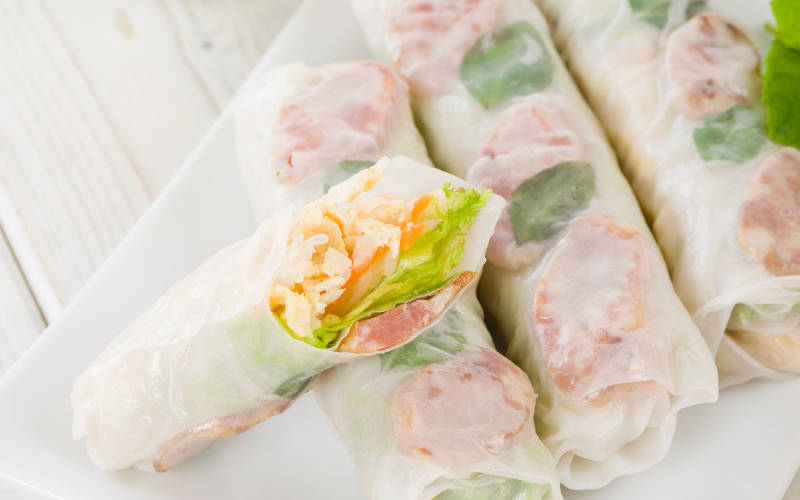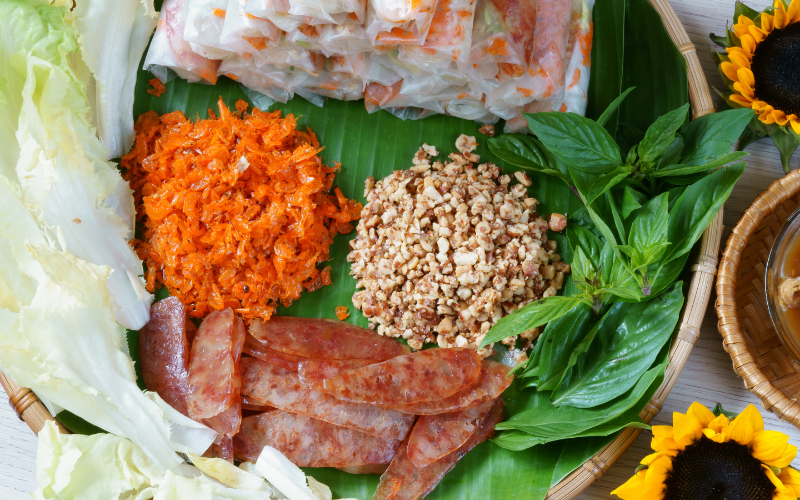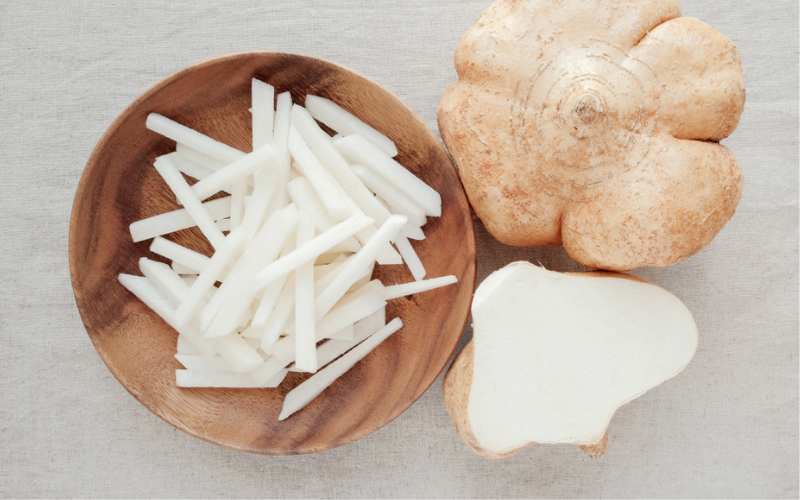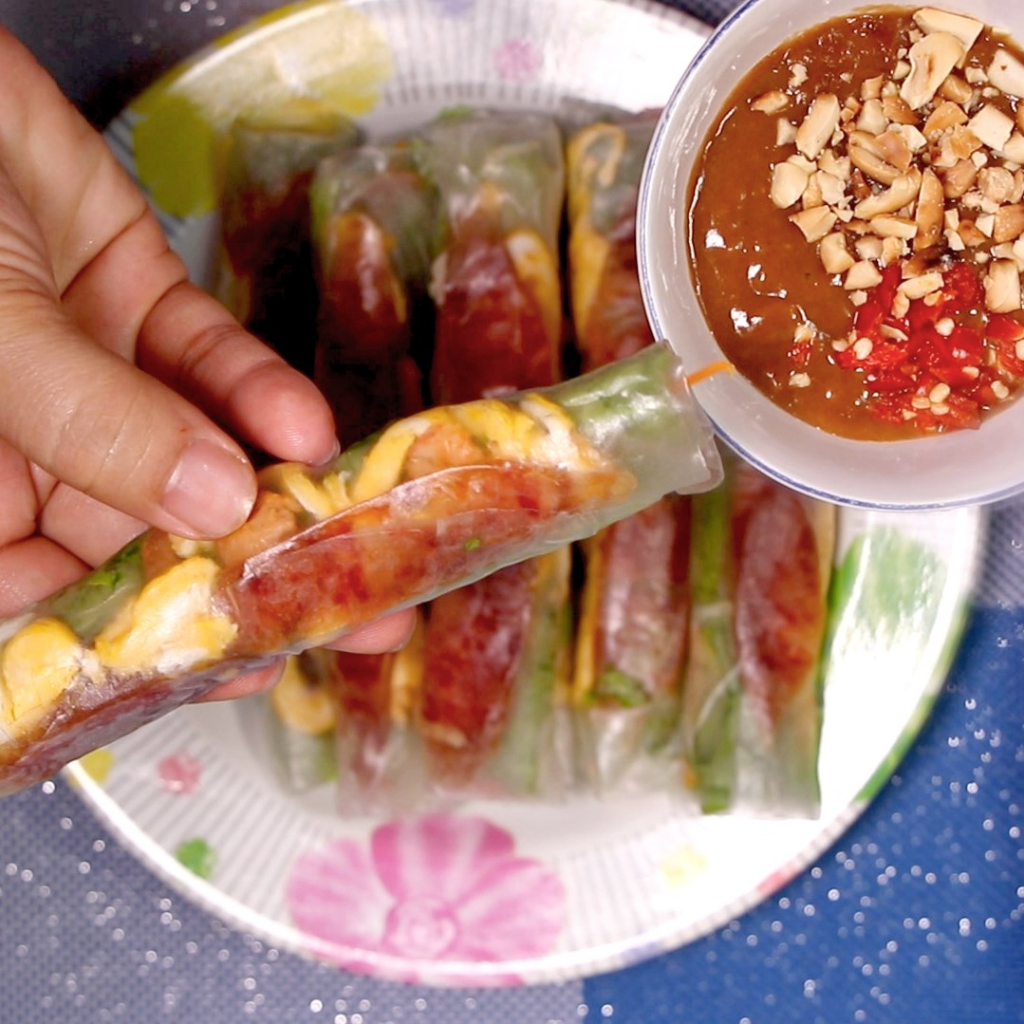In the rich tapestry of Vietnamese cuisine, one dish that stands out for its unique blend of flavors and textures is “Bo Bia“. These delectable Vietnamese spring rolls offer a delightful medley of fresh vegetables, tender meats, and aromatic herbs, all wrapped in a delicate rice paper.
Bo Bia has a fascinating history, and its popularity has spread far beyond the borders of Vietnam. In this article, we will take a closer look at the origins, ingredients, preparation, and cultural significance of Bo Bia.
What is Bo Bia?

Bo Bia, also known as Popiah, is a popular Vietnamese dish that originated from the Chinese popiah rolls but has been given a unique Vietnamese twist. It is essentially a type of spring roll or wrap made from wheat flour, typically filled with a delightful combination of ingredients.
What sets Bo Bia apart from the original Chinese version is the use of Vietnamese rice paper to wrap the fillings. Vietnamese rice paper is thin, translucent, and made from rice flour, water, and salt. It imparts a delicate and light texture to the rolls, making them distinctively Vietnamese.
The key ingredients

The traditional stuffing for Bo Bia includes a mix of yam, bean sprouts, jicama (a crunchy root vegetable), carrots, omelet, and lap xuong sausages, which are Chinese sausages. These ingredients create a harmonious blend of flavors and textures, ranging from the sweetness of the yam and carrots to the savory richness of the sausages.
Rice paper
Rice paper serves as the foundation of Bo Bia. Made from rice flour, water, and salt, these thin, translucent sheets are essential for wrapping delicious fillings. Not to be confused with egg roll wrappers, learn more about spring roll vs egg roll article.
Jicama

Jicama, a crunchy and slightly sweet root vegetable, is a central ingredient in Bo Bia. Thinly sliced jicama adds a refreshing and juicy texture to the rolls.
Chinese sausage
Chinese sausage, known as lap cheong, provides a savory and aromatic touch to Bo Bia. Its distinctive flavor sets this dish apart from other spring rolls.
Egg
A thin omelet or scrambled eggs are often included in Bo Bia, adding a delightful creaminess to the rolls.
Fresh herbs
Cilantro, Thai basil, and mint are commonly used fresh herbs that enhance the overall taste and aroma of the rolls.
Hoisin sauce
Hoisin sauce is commonly used as the main ingredient to make Bo Bia dipping sauce because of its rich and flavorful taste. The sauce’s consistency also prevents it from easily running off the rolls, making it easy and convenient to dip Bo Bia into the sauce without making a mess.
Preparing the perfect Bo Bia rolls
Soaking the rice paper
To begin making Bo Bia, soak the rice paper in warm water until it becomes pliable. Lay it flat on a clean surface, ready for the fillings.
Layering the ingredients
Place a thin layer of jicama, followed by the Chinese sausage, egg, and fresh herbs, on the rice paper’s lower third.
Rolling it right
Gently fold the bottom of the rice paper over the fillings and tuck it in. Roll it tightly halfway, then fold in the sides, creating a pocket. Continue rolling until you achieve a neat, cylindrical spring roll.
Serving with Vietnamese peanut sauce

Slice the Bo Bia into bite-sized pieces and serve with a side of peanut sauce for dipping. Here’s how to make Bo Bia sauce.
Ingredients:
- 1 tablespoon hoisin sauce
- 1 tablespoon peanut butter
- 1/4 cup water
- 1 teaspoon cornstarch
- 1 clove garlic, minced
- 1/4 teaspoon sriracha (optional)
- Toasted peanuts, for garnish
Instructions:
- In a small saucepan, whisk together the hoisin sauce, peanut butter, water, cornstarch, and garlic.
- Heat over medium heat, whisking constantly, until the sauce thickens, about 2 minutes.
- Remove from heat and stir in the sriracha, if desired.
- Serve warm or at room temperature, garnished with toasted peanuts.
Adjust peanut butter and hoisin sauce depending on your preference, more peanut butter will help the sauce have a more beautiful color.
Bo Bia variations
Vietnamese Jicama and Tofu Rolls (Bò Bía Chay): These vegan spring rolls feature a harmonious combination of ingredients, starting with the refreshing crunch of jicama and tofu. The soft and tender texture of tofu complements the crispness of jicama, while the fresh herbs add an aromatic and uplifting note to the rolls.
Sweet Spring Rolls (Bò Bía Ngọt): This sweet version is a delightful medley of flavors that appeals to those with a penchant for sugary delights. The star of this Bo Bia dessert is the shaved coconut, which adds a rich and creamy texture to the rolls. The natural sweetness of the coconut complements the other ingredients, creating a luscious and enticing treat.
Nutrition facts of Bo Bia
| Nutrient | Amount per Serving |
|---|---|
| Calories | 120 |
| Total Fat | 5g |
| Saturated Fat | 1.5g |
| Trans Fat | 0g |
| Cholesterol | 25mg |
| Sodium | 250mg |
| Total Carbohydrates | 15g |
| Dietary Fiber | 2g |
| Sugars | 3g |
| Protein | 5g |
| Vitamin D | 0mcg |
| Calcium | 25mg |
| Iron | 1mg |
| Potassium | 150mg |
FAQs
Is Bo Bia suitable for vegetarians?
Yes, Bo Bia can be easily adapted for vegetarians by excluding the meat and eggs and increasing the amount of vegetables and tofu.
Can you make Bo Bia ahead time?
Yes, you can make Bo Bia ahead of time, making it a convenient and practical option for gatherings and parties. Preparing Bo Bia in advance allows you to save time and ensures that the rolls are ready to serve when your guests arrive.
Are there any gluten-free options for the rice paper?
Yes, some brands offer gluten-free rice paper made from alternative flours like tapioca or mung bean.
What are some popular dipping sauces for Bo Bia?
Apart from hoisin sauce, peanut sauce and nuoc cham (fish sauce-based dipping sauce) are popular choices.
Can I add my favorite ingredients to Bo Bia?
Certainly! Bo Bia’s versatility allows you to get creative with the fillings and tailor the rolls to your taste.
How to keep Bo Bia from sticking?
To prevent Bo Bia from sticking, you can use damp kitchen towels or paper towels to separate the rolls. Lay a damp towel or paper towel between each roll to create a barrier and keep them from sticking together.
Conclusion
Bo Bia, the Vietnamese spring rolls, is a tantalizing culinary experience that captures the essence of Vietnamese flavors in a convenient and delightful package. With its roots in Southern Vietnam and its far-reaching popularity, Bo Bia has become a symbol of unity and celebration. Whether you savor it at a family gathering or explore its various regional adaptations, Bo Bia promises a gastronomic journey like no other.